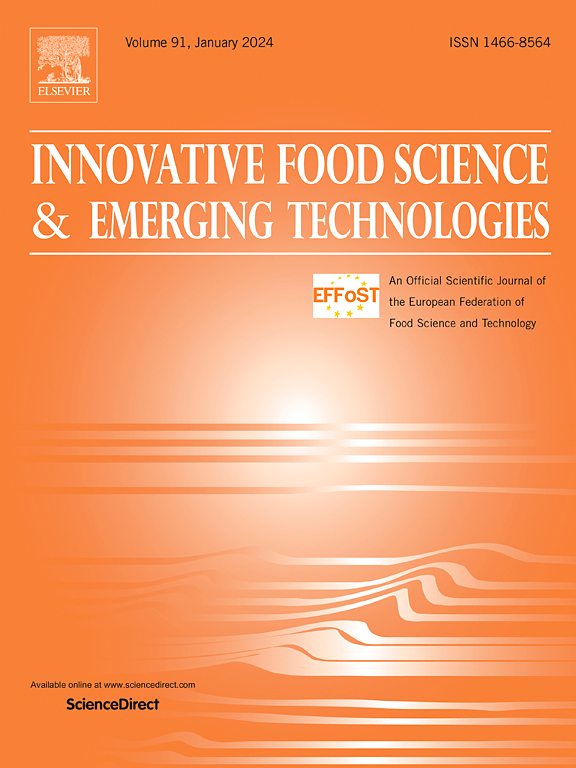Effects of dual modification by cold plasma and heat-moisture treatment on the structure and in vitro digestibility of waxy maize starch
IF 6.3
1区 农林科学
Q1 FOOD SCIENCE & TECHNOLOGY
Innovative Food Science & Emerging Technologies
Pub Date : 2025-03-07
DOI:10.1016/j.ifset.2025.103991
引用次数: 0
Abstract
Cold plasma technology with potential clean-label attributes applying in starch modification has gained intensive interest. In this study, waxy maize starch was subjected to cold plasma treatment at different discharge current (0.8 & 1.2 A), followed by heat-moisture treatment (HMT) under heating moisture of 20 % ∼ 30 %. The effects of dual modification on starch structural orders, functional characteristics and in vitro starch digestibility were investigated. X-ray diffraction and Fourier transform infrared spectroscopy revealed that plasma treatment disrupted crystallinity and double-helix order, whereas the structural orders was slightly increased when subjected to HMT under 20 % ∼ 25 % moisture, without altering the diffraction patterns or FTIR spectra of starch. The gel permeation chromatography observed that dual modification produced lower molecule weight with smaller radius of gyration. The prior plasma treatment was responsible for the loss of structural orders and chain depolymerization, whereas the sequential HMT contributed to restore impaired packing orders, mainly due to the molecular chain rearrangement. In addition, the dual-modified starch exhibited biphasic endothermic profile with distinct crystalline perfections and enhanced thermal stability. In vitro starch digestibility showed that the overall starch digestion rate and extent were significantly enhanced, in which the granular roughness and reduction in molecule weight played important roles. This study indicated that plasma-HMT modification could be a new strategy to fabricate starch with lower viscosity and enhanced hydrolysis susceptibility, which would broaden applications of plasma-involved starch modification in food industry.

冷等离子体和热湿双重改性对糯玉米淀粉结构和体外消化率的影响
冷等离子体技术具有潜在的清洁标签属性,应用于淀粉改性已受到广泛关注。本研究对蜡质玉米淀粉进行了不同放电电流(0.8 & 1.2 A)的冷等离子体处理,然后在加热水分为 20 % ∼ 30 % 的条件下进行热水分处理(HMT)。研究了双重改性对淀粉结构顺序、功能特性和体外淀粉消化率的影响。X 射线衍射和傅立叶变换红外光谱显示,等离子体处理破坏了淀粉的结晶度和双螺旋顺序,而在 20 % ∼ 25 % 的水分条件下进行 HMT 处理时,淀粉的结构顺序略有增加,但淀粉的衍射图样和傅立叶变换红外光谱未发生变化。凝胶渗透色谱法观察到,双重改性产生的分子量较低,回转半径较小。先前的等离子处理导致了结构秩序的丧失和链的解聚,而连续的 HMT 则有助于恢复受损的堆积秩序,这主要是由于分子链的重新排列。此外,双重改性淀粉表现出双相内热曲线,具有明显的结晶完善性和更高的热稳定性。体外淀粉消化率表明,整体淀粉消化率和消化程度显著提高,其中颗粒粗糙度和分子量的降低起到了重要作用。这项研究表明,等离子体-HMT 改性可以作为一种新的策略来制造粘度更低、水解敏感性更强的淀粉,这将拓宽等离子体参与淀粉改性在食品工业中的应用。
本文章由计算机程序翻译,如有差异,请以英文原文为准。
求助全文
约1分钟内获得全文
求助全文
来源期刊
CiteScore
12.00
自引率
6.10%
发文量
259
审稿时长
25 days
期刊介绍:
Innovative Food Science and Emerging Technologies (IFSET) aims to provide the highest quality original contributions and few, mainly upon invitation, reviews on and highly innovative developments in food science and emerging food process technologies. The significance of the results either for the science community or for industrial R&D groups must be specified. Papers submitted must be of highest scientific quality and only those advancing current scientific knowledge and understanding or with technical relevance will be considered.

 求助内容:
求助内容: 应助结果提醒方式:
应助结果提醒方式:


